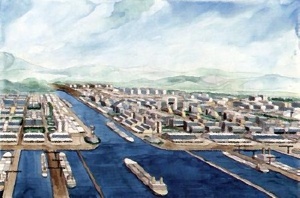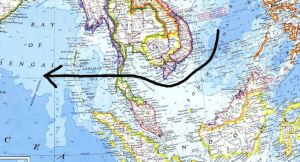The Thai Isthmus Canal: How a New Gateway to East Asia Could Enhance Regional Integration
Europe had its canal at Suez. By avoiding the perilous Cape of Good Hope and cutting over a thousand miles off a steamship trip from London to Bombay, the canal was, in the words of Prime Minister Anthony Eden, Britain’s “great imperial lifeline”. The Americans had theirs in Panama. It pushed America west; through its locks passed the hundreds of thousands of men and women who would go on to realize America’s Manifest Destiny.
A canal across the isthmus of Thailand, if ever built, promises to dramatically shake up existing trade routes, regional relationships and defence policy in East Asia, much as the Suez and Panama canals did for Europe and North America respectively. The enormous technical and financial resources needed to pull off such a feat of engineering would most likely require a wide consortium of investors, from the ASEAN members to China and Japan. Such East Asian involvement would render a Thai Canal the next instalment in a long established tradition of canal building by regional powers with global ambitions. Unlike the Panama and Suez canals however, the Thai canal would disrupt a well established, well regulated and popular shipping route.
Although China has the most to gain from a canal being built (it finds the current status quo wholly unstable and unsustainable), the project would be a boon to the entire East Asian region and ASEAN’s goal of regional integration. Major nations in East Asia are pitted against each other – on the Trans-Pacific Partnership, on what to do with North Korea, on island disputes in the East and South China Seas, and other issues. Joint development of common interests could bring conflicting parties together, in the spirit of peace, security and profit.
The Malacca Strait is strategically vulnerable. The sheer volume of trade and oil that flows through that chokepoint makes an alternative route extremely attractive. Despite this, no single country could, or would want to, fund the canal alone; a wide consortium is required to diversity risks and pool assets.
A new canal is not without risks. The Thai canal, in a bid to compete against the Malacca Strait, could grant vessels anonymous and unregulated passage. It would also be economically damaging to Singapore and Malaysia, whose ports have benefited from the monopoly. Chinese involvement in the financing or construction of the canal could pull Thailand further into its sphere of influence. The United States and Singapore have a long history of partnership in keeping the Malacca Straits open for business, cooperating on issues such as smuggling, piracy and environmental protection. A Thai canal would threaten Singapore’s control and could thus undermine American efforts in the region.
There are ways to control for this: an open and transparent financing instrument is essential, ideally with input from all ASEAN members, granting them shares much as European nations and private citizens were shareholders of the Suez Canal Company. ASEAN would have to be consulted; a need for the canal should be established at the next ASEAN Summit and further explored at the next meeting of transportation ministers. A renewed commitment by Thai authorities to fully incorporate and implement American anti-smuggling and proliferation agreements is also crucial.
Thailand would benefit from thousands of construction jobs and the national pride associated with a project over three hundred years in development. The project would also be a showcase for the ASEAN Way and, by obtaining Singaporean and Malaysian acquiescence, a testament to the consultative yet efficient organization they have built. This would also be an opportunity for South Korea, Japan and the Asian Development Bank to flex their financial muscles in building lasting regional relationships.
The canal should be built, with a diversified group of actors capitalizing an investment vehicle. Ultimately however, the Thai Canal needs to overcome a 300 year legacy of failure.
A slight pivot to East Asia
Born in Hawaii and partially raised in Indonesia, Obama has long wanted to be known as the first “Pacific President”. After 4 years in office, he has done little to earn that title. He is still stuck with what the administration called “inherited issues” in the Middle East, not to mention unrelenting political obstructionism at home. Europe and Canada still command the most respect while Northern and Eastern Africa pose new challenges.
It was first called a “Pacific Pivot” and was then rebranded as a “rebalancing”; while Obama keeps on using the pivot language in his speeches, no Pentagon policy document uses the term. Coupled with most of the administration’s Asia policy officials (Kurt Campbell, Jeffery Bader and James Steinberg) having left with Hillary Clinton, the pivot is looking increasingly shaky. Furthermore, European allies have not exactly welcomed this new language; rebalancing/ pivoting implies ‘less to us more to them’.
Not that the Americans have made any significant rearrangements – four littoral combat ships sailing in and out of Singapore and a few marine platoons rotating through Darwin. One impressing statistic is that 60% of America’s warships will be in the Pacific by 2020 although the fact that around 55% of America’s warships are already in the Pacific is often overlooked.
Hillary Clinton and John Kerry often talked of updating relations with their five regional treaty allies – Australia, Japan, Thailand, South Korea and the Philippines. So far this has not led to much. The Darwin plan is little more than a continuation of the 1951 ANZUS treaty, a military partnership described by the Australians as “insurance” and “hedging”. America’s hub and spoke strategy once served to distance potential East Asian rivals while bringing them under an American security umbrella. The legacy of this is that spoke-to-spoke relations are as fragile as they have ever been, with South Koreans overwhelmingly backing the PRC in its Senkaku Islands dispute with Japan.
On that note, the rebalancing was supposed to focus on South-East Asia and ASEAN rather than on North-East Asian problems. The Senkaku dispute and continued North Korean nuclear intransigence have made this more difficult. Beefing up defences in Guam and Okinawa has taken priority over sending military assets to the relatively safe ports of Darwin and Singapore. Even within the multilateral TPP negotiations, now in their 18th round, Japan’s farming lobby seems to be putting up the biggest resistance.
The Trans-Pacific Partnership (TPP) is a free trade agreement bringing together a dozen countries (but not China) which together account for 40% of global GDP and one third of all trade. It aims to set rules on intellectual property protection, investment, state owned enterprises and services. Indeed China’s exclusion makes it look like the trade policy arm of America’s broader containment-lite of China. Although all parties seem keen on its success and implementation, it is unlikely to be completed on time (within a year). Even if it were concluded (15 of the 29 chapters have yet to be negotiated) the US Congress could derail it just to deny Obama a victory and delegitimize his ‘pivot’ to Asia.
Obama’s failure to attend an Asia-Pacific Economic Co-operation forum (APEC) Bali in order to battle problems at home is rife with the symbolism of America’s declining influence. China and Russia’s presidents managed to attend. Indeed, Xijinping’s Asia road show directly contrasted with Obama’s repeated broken promises to pay more attention to the region. He showered the region with low interest loans and investment proposals. Obama’s failure to meet with Najib Razak, Malaysia’s prime minister, will strain Malaysian commitment to the TPP. The TPP is a hard enough sell there without this most recent disappointment; it would threaten the government’s racist affirmative action policies and the opposition is branding it as an American effort to “impose its brand of economic model”. For the Vietnamese too, which have an economic model dependent on state-owned enterprises, the TPP could wreak a lot of damage.
Eight TPP members (but not America) along with China, India and three APEC members are now talking about the Regional Comprehensive Economic Partnership, a skim milk free trade agreement without restrictions on state-owned enterprises (a TPP pillar which implicitly excludes China). Unless Obama rebalances (or pivots) his own strategic priorities, he could very well see his TPP and broader East Asian strategy pulled out from under him.


Recent Comments